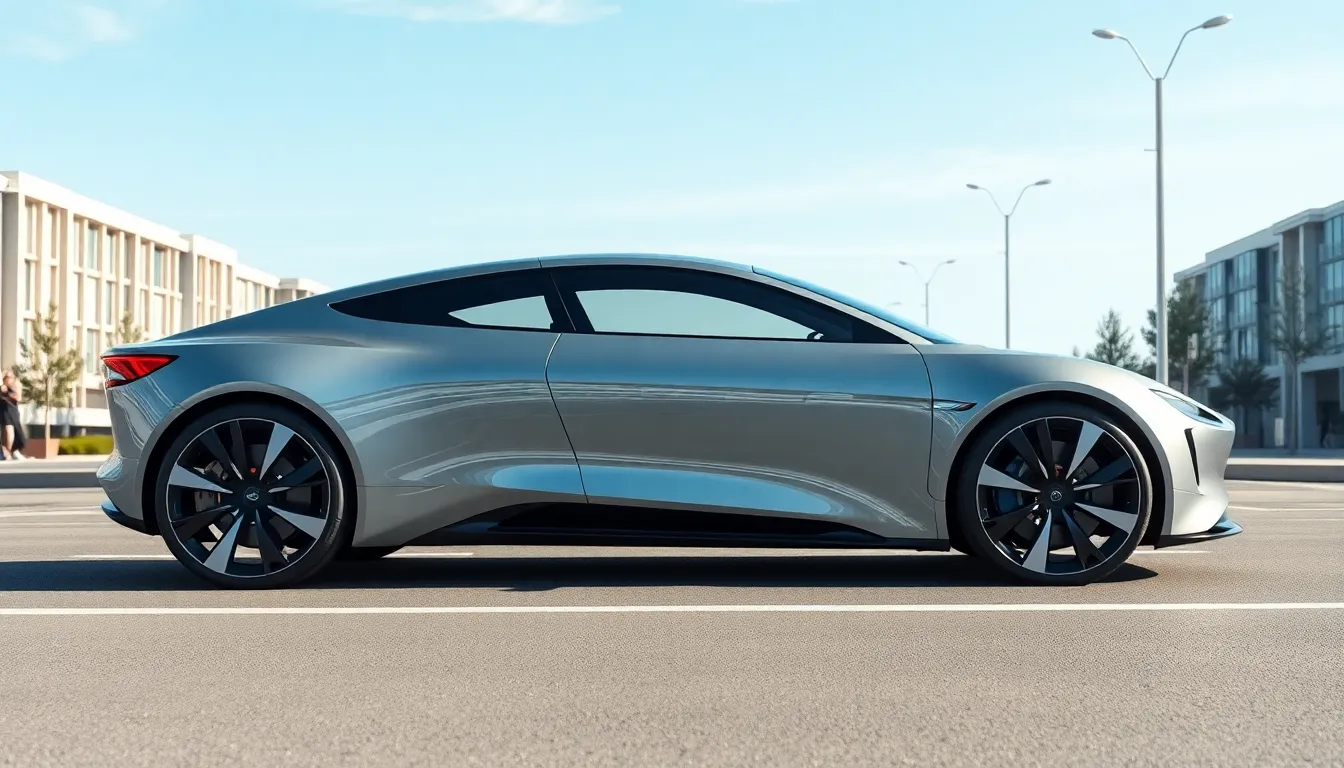Electric cars are zooming into the future, and their designs are turning heads faster than a toddler in a candy store. Gone are the days of boxy shapes and uninspiring aesthetics. Today’s electric vehicles are sleek, stylish, and packed with tech that makes even your smartphone feel a little jealous.
Imagine cruising down the street in a car that looks like it belongs in a sci-fi movie while knowing you’re helping the planet. It’s not just about saving the environment; it’s about making a statement. The evolution of electric car design is not just a trend; it’s a revolution that combines sustainability with jaw-dropping innovation. Buckle up as we explore the fascinating world of electric car design, where style meets sustainability and every curve tells a story.
Table of Contents
ToggleOverview of Electric Car Design
Electric car design showcases a remarkable journey from basic structures to sophisticated aesthetics. Modern electric vehicles feature streamlined designs that enhance aerodynamics. Sleek lines and innovative materials contribute to both performance and visual appeal.
Manufacturers focus on sustainability by using recyclable materials in their constructions. Integrating smart technology influences the designs significantly, with features like advanced infotainment systems and driver assistance tools. Many models also incorporate customizable lighting and folding mirrors, adding personal flair to functionality.
Innovations in battery technology influence the overall design, allowing for unique placement options that free up interior space. The growing popularity of electric cars prompts designers to balance form and function expertly. They aim to create distinct brands that resonate with environmentally conscious consumers while appealing to a broader audience.
Color palettes play a significant role, with manufacturers choosing vibrant options that stand out on the road. Furthermore, the push for energy efficiency has led to designs that maximize range and minimize drag. Electric car designs not only redefine traditional notions of style but also contribute to the shift towards a sustainable future.
Adapting to diverse consumer preferences becomes essential, as designers prioritize user experience without compromising on aesthetics. The evolution of electric car design continues to reflect technological advancements and changing societal values.
Key Elements of Electric Car Design

Electric car design incorporates various elements that enhance performance and aesthetics. Key aspects include aerodynamics, battery placement, and material selection.
Aerodynamics
Aerodynamics significantly impacts an electric car’s efficiency and performance. Designers prioritize smooth lines and streamlined shapes to minimize drag. A well-optimized exterior reduces energy consumption, which extends the driving range. Many electric vehicles feature tapered rear ends and smooth undercarriages, enhancing airflow. Optimized aerodynamics not only improves efficiency but also contributes to visual appeal.
Battery Placement
Battery placement plays a crucial role in electric vehicle design. Engineers position batteries in the vehicle’s floor to lower the center of gravity. This strategic location enhances stability and handling, improving the driving experience. Additionally, thoughtful battery arrangement maximizes interior space, allowing for innovative cabin layouts. Designers aim for a balance between functionality and aesthetics, integrating batteries without compromising style.
Material Selection
Material selection is vital to sustainable electric car design. Manufacturers increasingly use lightweight and recyclable materials to improve efficiency. Components like aluminum and high-strength steel contribute to reduced weight while maintaining safety. Eco-friendly materials, such as plant-based composites, are gaining popularity for their lower environmental impact. Thoughtful material choices not only enhance performance but also align with the values of environmentally conscious consumers.
Innovative Design Features
Electric cars feature innovative design elements that cater to both functionality and aesthetics. These qualities enhance user experience while embracing sustainability.
Interior Layout
Flexible interior layouts define modern electric vehicles. Unique arrangements allow for more spacious cabins, offering comfortable seating and ample cargo space. Designers prioritize lower floors for improved accessibility and connection to the road. The absence of traditional engine compartments creates room for creative storage solutions. Each layout reflects a commitment to maximizing utility without sacrificing style.
User Interface and Technology
User interface design in electric cars emphasizes simplicity and intuitiveness. Touchscreen displays serve as centralized control hubs, integrating navigation, climate control, and entertainment systems. Enhanced connectivity options, such as smartphone integration, ensure drivers stay informed and entertained. Voice recognition technology improves safety by allowing hands-free operation of features. These advancements in technology showcase a focus on user-friendly experiences while supporting eco-conscious values.
Sustainability in Electric Car Design
Sustainability plays a critical role in the design of electric cars. Manufacturers focus on utilizing recyclable materials to reduce environmental impact. Examples include recycled plastics and metals, which minimize waste and lower carbon footprints.
Innovations in battery technology contribute significantly to sustainable design. Enhanced energy density allows for smaller, lighter battery packs that occupy less space, resulting in improved aerodynamics. Designers strategically position these battery packs lower in the vehicle, reducing the center of gravity and increasing stability.
User-friendly interior layouts prioritize accessibility and functionality while maintaining an eco-conscious approach. Flexible seating arrangements provide spacious cabins and innovative storage solutions, enhancing the overall user experience.
Utilizing lightweight materials not only boosts performance but also aligns with eco-friendly values. Materials such as carbon fiber and aluminum offer strength and durability while significantly decreasing vehicle weight. Designers often incorporate energetic color palettes that reflect environmental priorities, appealing to a broader audience.
Embedded smart technologies further advance sustainability. Advanced driver assistance systems promote efficient driving habits, reducing energy consumption and extending range. Infotainment systems provide information on charging stations and energy usage, empowering drivers to make more informed choices.
Electric car design continuously responds to evolving societal values. Designers aim to create vehicles that reflect a commitment to innovation and responsibility. Overall, the harmonious blend of aesthetic appeal, functionality, and sustainability defines modern electric car design.
Future Trends in Electric Car Design
Emerging trends in electric car design reflect a growing emphasis on sustainability and user experience. Manufacturers increasingly incorporate advanced materials, like bioplastics and recyclable composites, into their vehicles. Another trend is the integration of artificial intelligence, which enhances driver assistance features and optimizes energy management.
The use of modular design allows for easier updates and customization. Designers focus on creating adaptable interiors that can cater to various needs, from spacious passenger rooms to added cargo space. Electric vehicles are also seeing an increase in personalized aesthetics, with customizable exterior options to attract diverse consumer preferences.
Collaboration between automakers and tech companies fosters innovative features. Smart connectivity options, including vehicle-to-grid technology, make electric cars part of a broader energy ecosystem. Greater attention is given to aerodynamics, leading to sleeker silhouettes that improve efficiency.
Consumer preferences shape new functionalities. Enhanced infotainment systems integrate seamlessly with smartphones, creating an immersive driving experience. Voice commands and gesture controls simplify interactions, ensuring safety while driving.
New safety features are being developed with a focus on active protection. Designers incorporate more sensors and cameras to enhance situational awareness on the road. Additionally, attention is directed toward improving overall performance through battery innovations that extend range and reduce charging time.
Sustainable production processes are receiving more attention. Manufacturers aim to minimize waste and carbon footprint while encouraging ethical sourcing of materials. This holistic approach to design ensures that electric cars not only meet consumer demands but also contribute positively to the environment.
The evolution of electric car design showcases a remarkable blend of style and sustainability. As manufacturers continue to innovate, they’re creating vehicles that not only meet the demands of eco-conscious consumers but also appeal to a wider audience. The focus on aerodynamics, material selection, and smart technology is redefining user experience while prioritizing environmental responsibility.
Future trends promise even more exciting developments in design and functionality. With advancements in materials and artificial intelligence, electric cars are set to become even more efficient and user-friendly. This ongoing transformation reflects a commitment to innovation that aligns with changing societal values, ensuring that electric vehicles remain at the forefront of the automotive industry.





